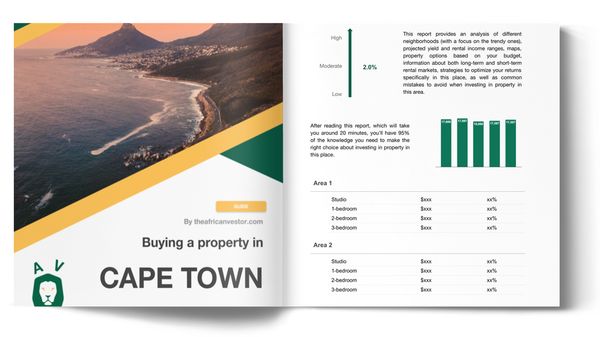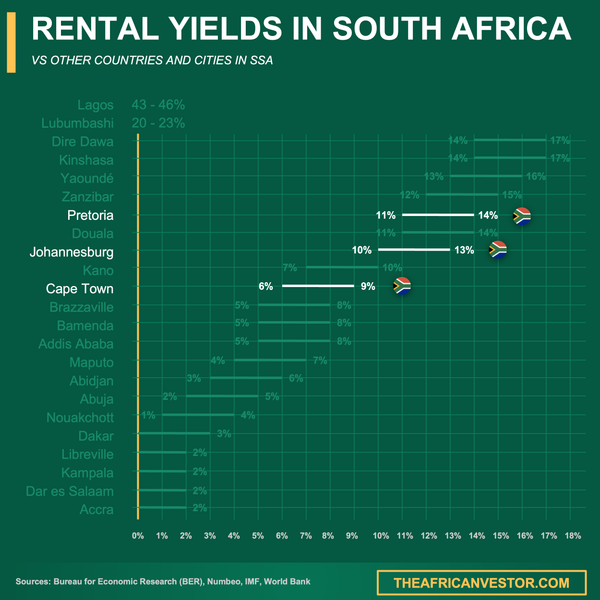Authored by the expert who managed and guided the team behind the South Africa Property Pack

Yes, the analysis of Cape Town's property market is included in our pack
Observatory has emerged as one of Cape Town's most dynamic neighborhoods for property investment and gentrification.
Property prices in Observatory have surged approximately 30% over the past five years, with apartments averaging R28,114 per square meter and houses at R17,094 per square meter as of September 2025. The area attracts significant investor interest, with 60-65% of recent buyers being investors rather than owner-occupiers, driven by rental yields exceeding 8% and strong demand from UCT students and young professionals.
If you want to go deeper, you can check our pack of documents related to the real estate market in South Africa, based on reliable facts and data, not opinions or rumors.
Observatory property prices have increased 25-30% over five years, with apartments outperforming houses and rental yields exceeding 8%.
Multiple new developments are underway while gentrification pressures displace lower-income residents, creating both investment opportunities and social concerns.
| Property Type | Current Price per m² | 5-Year Growth | Rental Yield |
|---|---|---|---|
| Apartments | R28,114 | 30% | 8%+ |
| Houses | R17,094 | 29% | 7-8% |
| One-bedroom rental | R9,000-R10,000/month | 20-33% since 2020 | - |
| Two-bedroom rental | R13,000-R14,500/month | 24-38% since 2020 | - |
| Vacancy rates | 2-4% residential | Very low | - |
| Buyer profile | 60-65% investors | Investment-driven | - |

How much have property prices in Observatory increased over the past five years?
Observatory property prices have experienced substantial growth over the past five years, significantly outperforming many other Cape Town neighborhoods.
Apartments have been the strongest performers, with sectional title properties averaging R28,114 per square meter in September 2025, up from approximately R21,500 per square meter five years ago. This represents a remarkable 30% increase over the period.
Freestanding houses have also shown strong appreciation, currently averaging R17,094 per square meter compared to about R13,200 per square meter five years ago. This translates to approximately 29% growth, slightly below apartment performance but still robust.
Commercial spaces in Observatory have followed the upward trend, with rental rates in the lower to middle ranges (R40-120 per square meter per month) steadily rising alongside the area's growing popularity among businesses and creative professionals.
Overall, Observatory and similar emerging areas have seen property values increase by 25-30% over the past five years, making it one of Cape Town's best-performing property markets.
What are current property prices per square meter in Observatory compared to nearby areas?
Observatory's current property prices position it competitively within Cape Town's inner suburbs, with values comparable to similar gentrifying areas.
| Suburb | Average Price per m² | Market Characteristics |
|---|---|---|
| Observatory | R18,000 - R22,000 | Mixed apartments and houses, premium properties at higher end |
| Woodstock | R18,000 - R22,000 | Similar pricing, slightly more advanced redevelopment |
| Salt River | R16,000 - R20,000 | Rapid new development phase, smaller historical base |
| Rondebosch | R23,000 - R28,000 | Established area, university proximity, higher average prices |
| Cape Town Central | R25,000 - R35,000 | Premium city center location with higher density |
How many new developments are currently underway in Observatory?
Observatory is experiencing significant development activity, with multiple major projects transforming the neighborhood's landscape.
As of September 2025, an estimated 8-12 major residential and mixed-use developments are currently under construction or recently approved in Observatory. The most prominent project is the River Club development, which includes Amazon's new headquarters alongside commercial, hotel, and residential components.
Observatory Green represents another significant mixed-use development that will add substantial residential stock to the area. These developments are tracked by the Observatory Development Tracker, which maps ongoing and planned projects throughout the neighborhood.
The development pipeline includes various scales of projects, from boutique apartment buildings to large-scale mixed-use complexes. This construction boom reflects developer confidence in Observatory's growth potential and sustained demand from investors and residents.
It's something we develop in our South Africa property pack.
What rental yields can investors expect in Observatory?
Observatory offers attractive rental yields that exceed Cape Town's average, making it particularly appealing to property investors.
Current rental yields in Observatory exceed 8% for well-located apartments, significantly above Cape Town's mid-market average of 5-6%. This performance places Observatory on par with other popular investment areas like Woodstock and Salt River.
The area's rental yields surpass those in more established neighborhoods like Rondebosch, which typically achieves 6-7% yields. Observatory's higher yields reflect the strong demand from UCT students and young professionals who are willing to pay premium rents for convenient location and modern amenities.
Studio and one-bedroom apartments tend to achieve the highest yields due to intense student demand, while larger properties also perform well with young professional tenants. The combination of rising rents and relatively accessible purchase prices maintains Observatory's yield advantage.
Short-term rental opportunities through platforms like Airbnb can potentially enhance yields further, particularly for properties near UCT or transport links.
Don't lose money on your property in Cape Town
100% of people who have lost money there have spent less than 1 hour researching the market. We have reviewed everything there is to know. Grab our guide now.

How have rental prices changed for apartments since 2020?
Observatory apartment rental prices have increased substantially since 2020, reflecting the area's growing desirability and broader market trends.
One-bedroom apartments have experienced significant growth, with monthly rents rising from approximately R7,500 in 2020 to R9,000-R10,000 in September 2025. This represents a 20-33% increase over the five-year period.
Two-bedroom apartments have seen even stronger rental growth, increasing from around R10,500 per month in 2020 to R13,000-R14,500 currently. This reflects a 24-38% rise, demonstrating particularly strong demand for larger units from young professionals and small families.
The rental increases accelerated post-pandemic as demand spiked from returning students and professionals seeking quality accommodation near UCT and central Cape Town. Limited supply of new rental stock during 2021-2022 further drove up prices.
Current rental trends show continued upward pressure, with vacancy rates remaining extremely low at 2-4% for residential properties, supporting landlords' ability to achieve premium rents.
What percentage of recent buyers are investors versus owner-occupiers?
Observatory's property market is heavily investor-driven, reflecting the area's strong rental potential and redevelopment prospects.
Recent years have seen approximately 60-65% of Observatory property buyers being investors rather than owner-occupiers. This investor dominance reflects the area's attractive rental yields exceeding 8% and strong capital appreciation potential.
The high investor proportion is driven by several factors including Observatory's proximity to UCT, excellent transport links, and ongoing gentrification that promises continued value growth. Many investors are attracted by the opportunity to purchase properties below peak values while benefiting from immediate rental income.
Owner-occupier buyers typically include young professionals, academics, and creative professionals who value Observatory's bohemian character and convenient location. However, rising prices are gradually pushing some first-time buyers toward other areas.
The investor-heavy market creates strong rental demand but also contributes to affordability challenges for potential owner-occupiers, particularly young locals and families seeking to purchase their first homes.
How has student and young professional demand affected rental markets?
UCT students and young professionals have fundamentally shaped Observatory's rental landscape, creating robust demand across both short-term and long-term markets.
The student population drives consistent demand for affordable one and two-bedroom apartments, with peak leasing activity occurring before each academic term. This demand supports premium rents and low vacancy rates throughout the year.
Young professionals, attracted by Observatory's trendy cafes, proximity to the city center, and transport links, compete for quality rental properties, often willing to pay premiums for modern amenities and good locations. This demographic shift has elevated the area's rental market profile.
Short-term rental markets benefit significantly from student and professional demand, with Airbnb operators achieving strong occupancy rates, particularly during university terms and academic conferences. Studio and compact apartments perform especially well in the short-term market.
The combined student and professional demand has created a virtuous cycle where landlords invest in property improvements, attracting higher-quality tenants willing to pay increased rents, further boosting the area's desirability and property values.
It's something we develop in our South Africa property pack.
What infrastructure projects are planned around Observatory?
Observatory benefits from several significant infrastructure projects that will enhance property values and area accessibility.
The River Club development anchors major infrastructure improvements including new roadways, bridges, and comprehensive riverine rehabilitation. These upgrades will significantly improve traffic flow and connectivity between Observatory and surrounding areas.
Public transport enhancements are planned as part of Cape Town's broader mobility strategy, including potential MyCiTi bus route extensions and improved rail connections that will benefit Observatory residents and property values.
Water and electricity infrastructure upgrades are ongoing throughout the area, addressing capacity constraints and improving service reliability. These essential service improvements support continued residential and commercial development.
Green infrastructure projects include riverfront rehabilitation and new public spaces that will enhance Observatory's livability and attractiveness to residents and visitors. These environmental improvements align with Cape Town's sustainability goals while boosting property appeal.

We did some research and made this infographic to help you quickly compare rental yields of the major cities in South Africa versus those in neighboring countries. It provides a clear view of how this country positions itself as a real estate investment destination, which might interest you if you're planning to invest there.
What are current vacancy rates for rental and commercial properties?
Observatory maintains exceptionally low vacancy rates across residential properties, reflecting strong ongoing demand from students and professionals.
Residential apartment vacancy rates are currently estimated at just 2-4%, well below Cape Town's overall average. This tight rental market supports landlords' ability to achieve premium rents and provides confidence for property investors.
The low residential vacancy reflects sustained demand from UCT students, young professionals, and the area's growing reputation as a desirable living location. Properties typically rent within days or weeks of becoming available, particularly those offering modern amenities or prime locations.
Commercial vacancy rates are slightly elevated compared to residential but have been stabilizing following pandemic disruptions. Creative industries, tech startups, and service businesses are increasingly choosing Observatory for its affordable commercial space and trendy atmosphere.
Retail vacancy rates vary by location within Observatory, with spaces near main transport routes and student accommodation areas maintaining higher occupancy than peripheral locations.
How have interest rate hikes affected Observatory property sales?
South African interest rate increases since 2022 initially impacted Observatory property sales volumes, but the market demonstrated remarkable resilience and recovery.
Higher interest rates briefly cooled sales activity during 2023, as potential buyers faced increased borrowing costs and tighter lending criteria. Transaction volumes decreased temporarily as some buyers delayed purchases or sought alternative financing arrangements.
However, Observatory's market recovered more rapidly than many other Cape Town areas due to its robust rental yields and strong redevelopment prospects. Investors remained attracted by the area's 8%+ rental yields, which helped offset higher financing costs.
Cash buyers and investors with existing property portfolios maintained activity levels throughout the interest rate cycle, taking advantage of reduced competition from mortgage-dependent buyers to secure properties at slightly better prices.
As of September 2025, sales volumes have largely normalized, with continued strong demand from both investors and owner-occupiers who recognize Observatory's long-term value proposition despite higher borrowing costs.
What evidence exists of resident displacement due to gentrification?
Observable evidence indicates that lower-income residents are experiencing displacement pressure in Observatory due to rising rents and property redevelopments.
1. **Rental displacement**: Long-term residents report being unable to afford rent increases, with many forced to relocate to areas further from central Cape Town and employment opportunities. 2. **Property redevelopment**: Older rental properties are being renovated or demolished for upmarket developments, reducing affordable housing stock and displacing existing tenants. 3. **Commercial gentrification**: Traditional local businesses are being replaced by trendy cafes and boutiques targeting higher-income demographics, changing the area's character and affordability. 4. **Community activism**: Local organizations and residents have raised concerns about gentrification pressures, with ongoing advocacy for affordable housing preservation and community protection. 5. **Demographic shifts**: Census and survey data indicate changing neighborhood demographics, with increasing proportions of young professionals and students relative to established lower-income families.What do analysts forecast for Observatory property prices over the next three years?
Property analysts and local estate agents maintain optimistic forecasts for Observatory's property market over the next three years, predicting continued steady growth.
Annual price increases of 3-6% are forecast for Observatory properties from 2025-2028, driven by persistent rental demand, improved infrastructure, and sustained developer interest. This growth rate aligns with broader Cape Town property market expectations while potentially outperforming due to Observatory's specific advantages.
Market sentiment remains positive among estate agents, particularly for investor-focused properties that can capitalize on strong rental yields and ongoing area improvements. The combination of UCT proximity, transport links, and cultural amenities supports long-term value growth.
However, analysts note potential risks including affordability constraints that could limit buyer pools, continued gentrification pressures that might prompt policy interventions, and broader economic factors affecting Cape Town's property market performance.
The development pipeline, including major projects like River Club, is expected to enhance Observatory's profile and property values while potentially increasing supply that could moderate price growth in certain segments.
It's something we develop in our South Africa property pack.
Conclusion
This article is for informational purposes only and should not be considered financial advice. Readers are advised to consult with a qualified professional before making any investment decisions. We do not assume any liability for actions taken based on the information provided.
Observatory represents one of Cape Town's most dynamic property investment opportunities, combining strong historical performance with promising future prospects.
While gentrification creates investment opportunities through rising property values and rental yields, it also raises important questions about community displacement and affordability that investors should consider when making decisions.
Sources
- The AfricanVestor - Cape Town Price Forecasts
- BambooRoutes - Cape Town Real Estate Trends
- The AfricanVestor - Buy to Let South Africa
- Rawson - Spotlight on Woodstock Salt River Observatory
- The AfricanVestor - Average Price per SQM Cape Town
- CBN - River Club Development Takes Shape
- Property Developments - Observatory Green
- Observatory Civic Association - Development Tracker
- Property24 - Observatory Property Trends
- Hoom - Cape Town Rental Market
